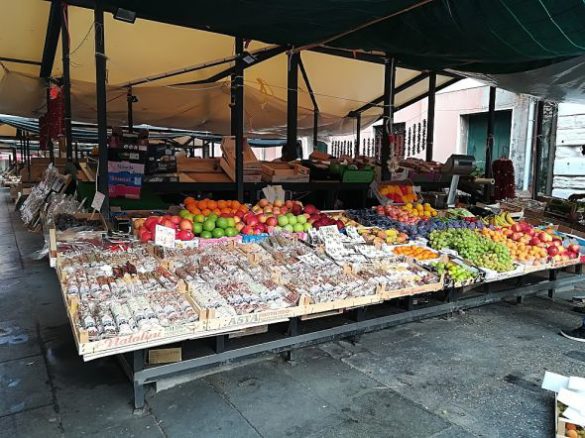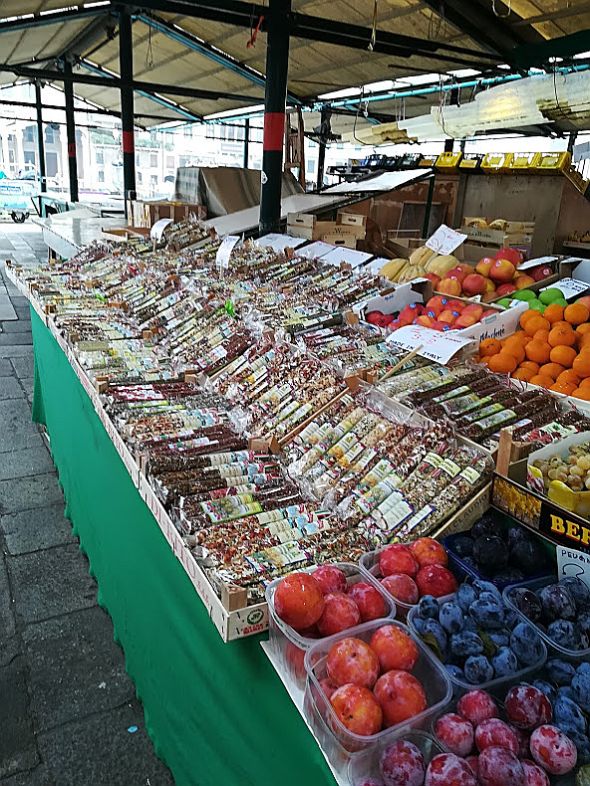Search results
56 results found.
56 results found.
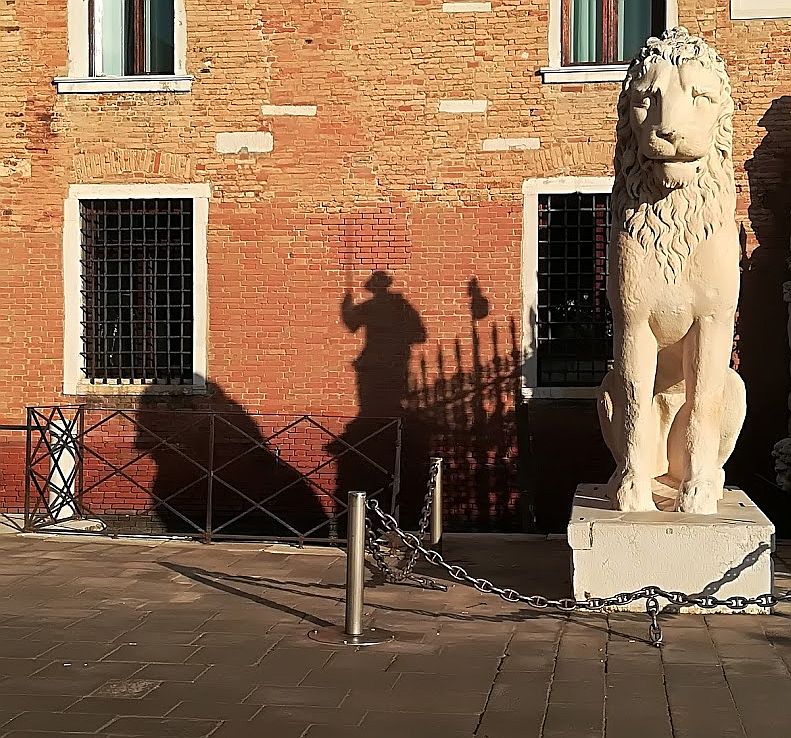
In my last post I insensitively described small-business owners (shops, restaurants, hair salons, etc.) as “howling” to reopen. If I were in their place, I would be howling too. And the same anguished cries are being heard throughout Italy — in Florence, Rome, Milan, in hill towns and beach resorts and places you’ve never heard of — as the bills and “Overdue Rent” notices continue to drop through the slot in the locked doors of shuttered stores of every kind. But the reopening is planned in stages, and belonging to a category whose stage has yet to arrive is heating up everybody’s atmosphere. More on that in my next.
At the beginning of the quarantine in Venice, when silence fell and motion ceased, a few people wrote to me expressing variations on “You must be enjoying the peace and quiet!” I know they would never have written that to a widow just returning home from the funeral, but it seemed similarly inappropriate. I understood that they meant that compared to the chaos and unpleasantness of being overrun by tourists, the opposite extreme ought to be a welcome relief. It wasn’t, it isn’t, it can’t be. One extreme is a bad correction of another extreme. Even on the first day of quarantine I realized that the quiet did not signify peace — au very much contraire. We have listened for two months to a silence that might have been that of the world underwater when you’re trying to see how long you can hold your breath.
But the non-essential small-business owners and artisans and their colleagues and cohorts and conjunctions have been living in a world of -3,000,000 per cent peace and quiet because they’ve been closed for two months — and in many cases, it will be three. And many of their businesses depend on tourists, which apparently have gone extinct.
Please note: No more tourists isn’t a problem just for Venice. This is a European, even global, phenomenon. A recent report by a group of analysts estimated that in the month of March, the tourist income in Europe shrank 68 per cent relative to that month last year. ENIT, the Italian national tourist agency, reports that bookings for Italy from April 13 to May 24 are down 84.6 per cent relative to the same period last year. (For the record, bookings to France are down by 82.9 per cent, and to Spain 80.3 per cent.) ENIT predicts that tourism to Italy won’t be back to pre-2020 levels till at least 2023.
High season? Where?
What can there be in Venice but tourism? This is a question that people have been struggling with since before I came here in 1994, and have continued to struggle with as the monster grew and grew, like Audrey in “The Little Shop of Horrors,” constantly bellowing “Feed me!” I hope somebody has been spending their stuck-at-home time studying whether anything else can keep Venice going, because this is the moment to step forward.
Happily for us, the world is coming back to life in via Garibaldi and environs; the first signs were a very sunny Sunday and the following two days. More motorboats in the canals, more people out on the street, suddenly children were everywhere, running around and shrieking — it’s great. It’s like some safety valve suddenly popped open.
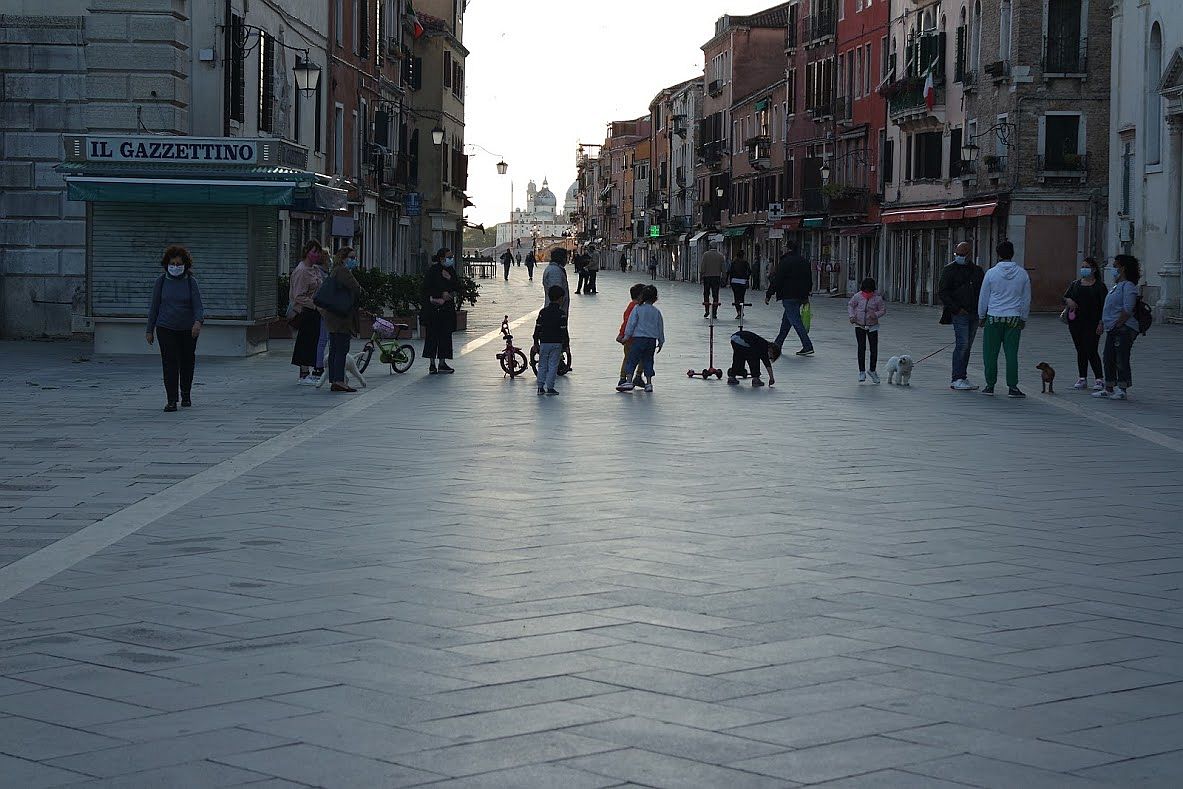
Some stores have been opening very gradually. There were those that remained closed from the first day, and will have to remain closed till the official permission is granted (see chart below). Others shortened their hours to opening only in the morning. The supermarket closed early, and remained shut on Sunday. I’ll be interested to see if that continues.
Over the past week or ten days, a few businesses (the office-supply/giftwrap/school supply store, the children’s clothes shop) were open all day, but only on Tuesday and Wednesday. It was an adventure trying to keep track of what you could get, and when, but I was surprised at how quickly one could adapt. The daily round just took more planning, and more willingness to wait in line.
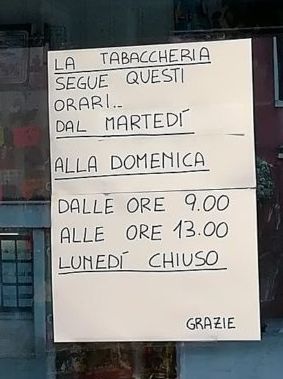


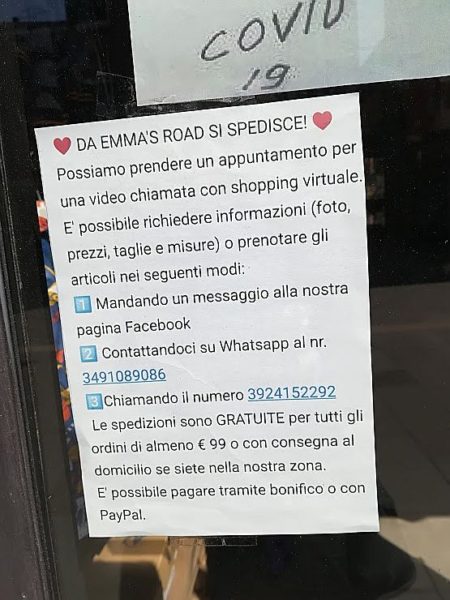
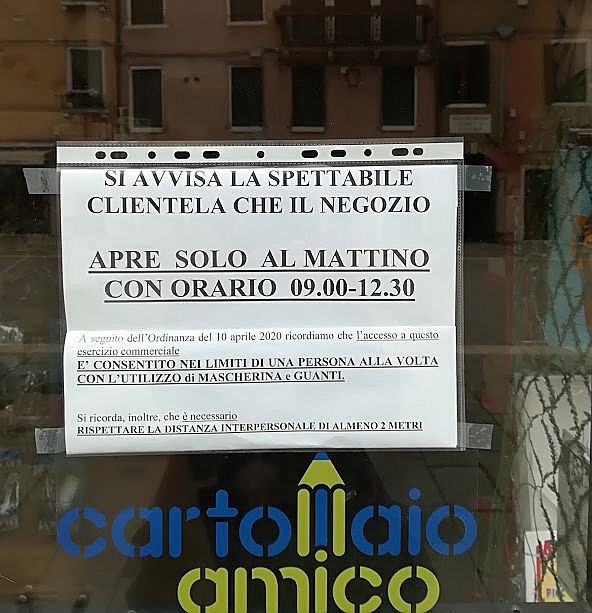
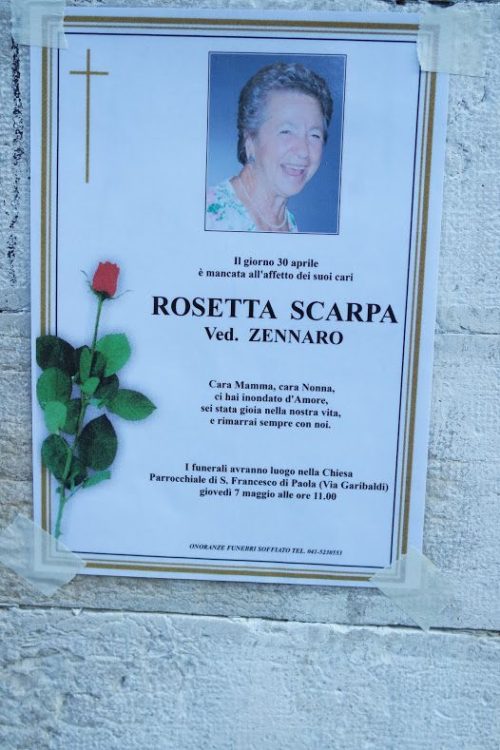
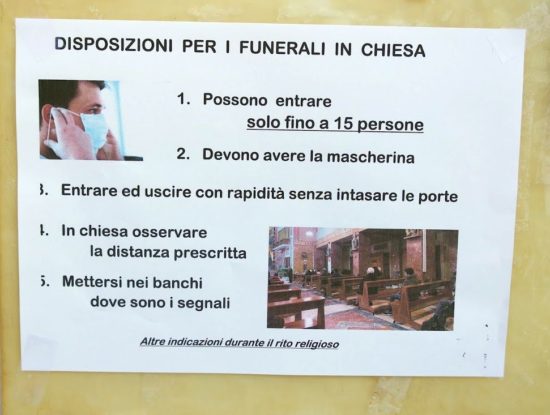
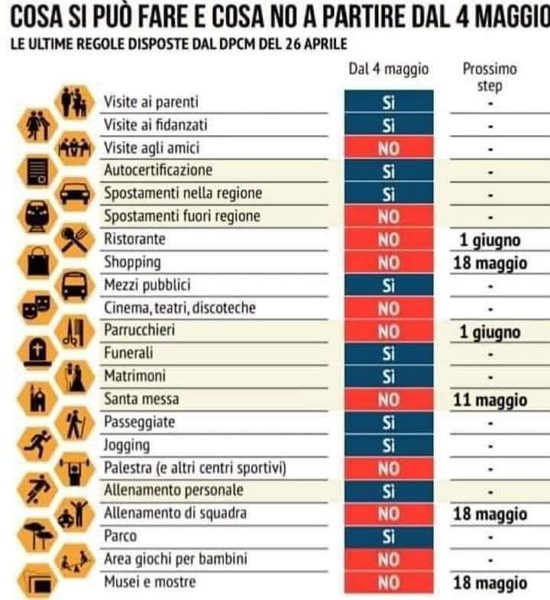
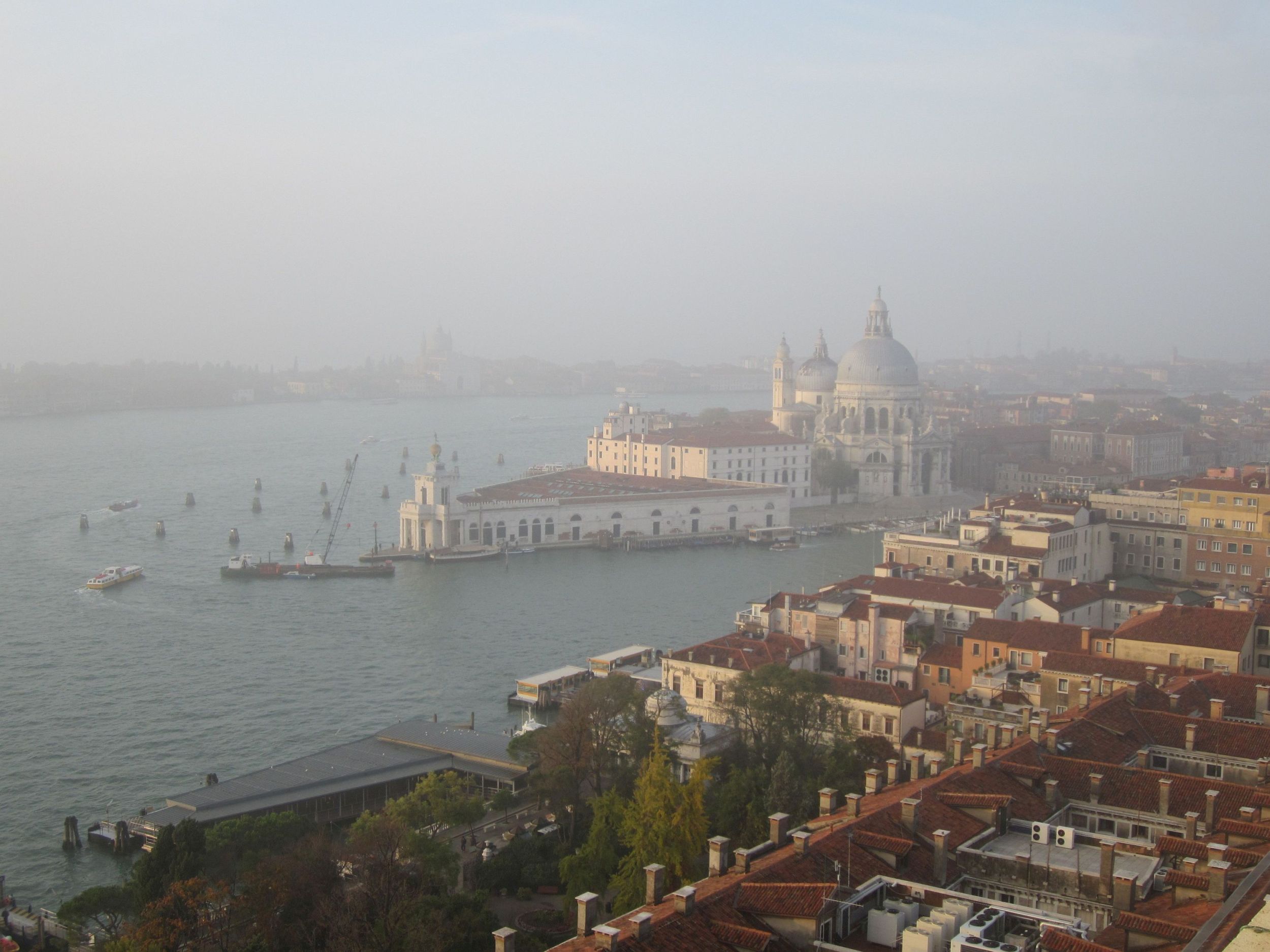
The division of history into the still-common categories of B.C. and A.D. is rendered in Italian as A.C. and D.C. (not to be confused with electric current or rock bands). It stands for “Avanti Cristo” and “Dopo Cristo” (before and after Christ).
I’m going to propose we keep using A.C. and D.C., but now they’re going to stand for “Avanti Coronavirus” and “Dopo Coronavirus.”
Before Coronavirus, we had problems with tourism (which immediately became problems without tourism). And we had acqua alta. And we had MOSE, and still have MOSE, and will always have MOSE till eternity has been reduced to the nucleus of the hydrogen atom and is extinguished.
To recap: Acqua alta is something that happens. It can be extreme, and sometimes extremely damaging. So it was decided, after the still-champion event of November 4, 1966, that the solution would be barriers composed of mobile “gates” that would be raised to block the water’s entrance into the lagoon, a/k/a Venice. (I make that distinction because the MOSE people don’t care about the lagoon — it is being built to protect the city. The damage that this construction has done and continues to do to the lagoon isn’t mentioned by the MOSE people, but it remains nevertheless.)
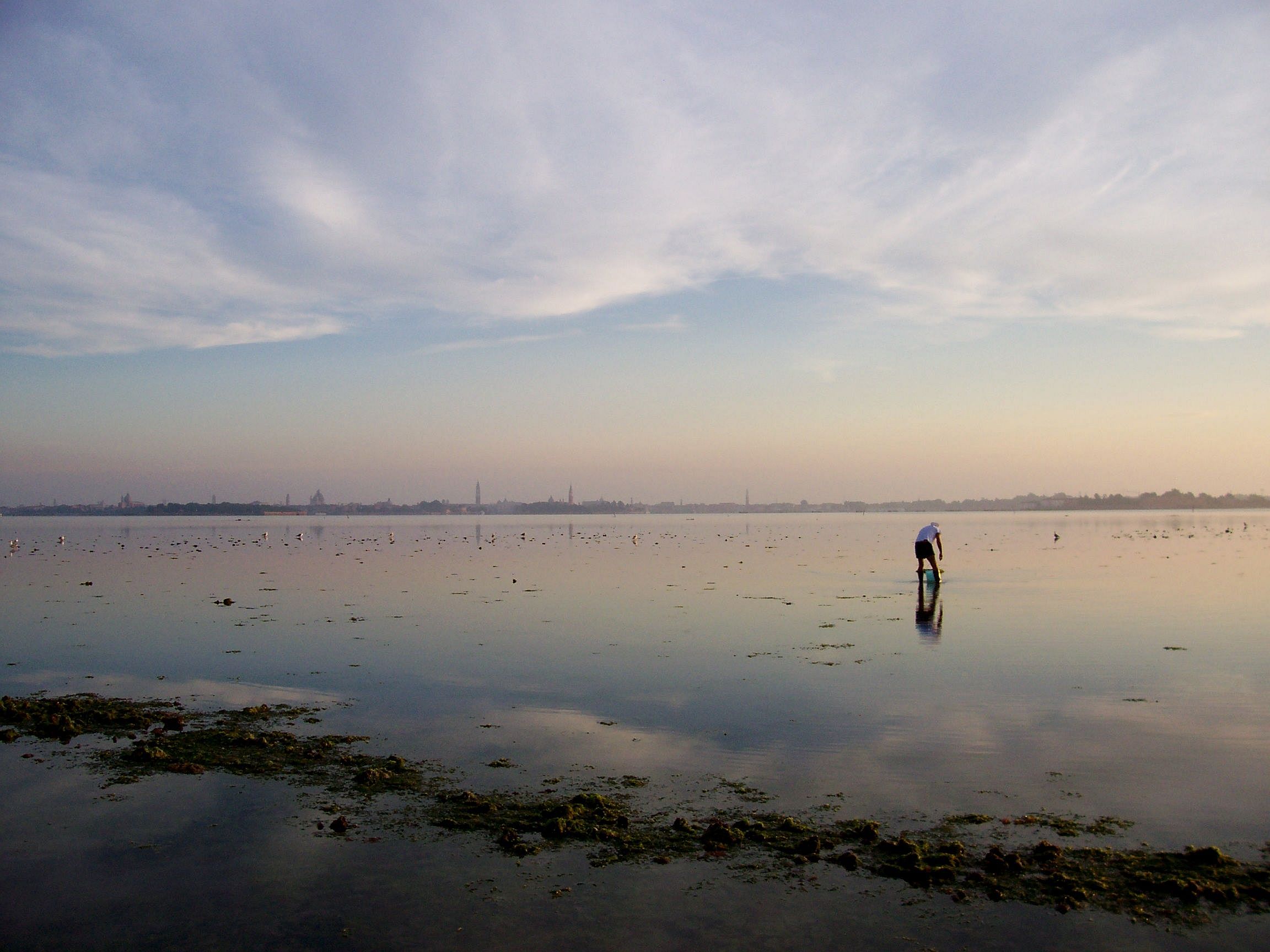
How are things going? Well, about as usual, which means moving ahead by fits and starts, badly and expensively. This form of progress attracted notice from time to time until the catastrophic acqua alta on November 12, 2019 that simultaneously drowned and battered the city. The morning after was full of wailing, as you would expect, and among those wails were angry voices saying that if MOSE had ever been finished on time (like, at least ten years ago) and in working order (this will always be doubtful), the city would not have suffered this appalling disaster. The rough translation would be “Hey — those floodgates you all have been blowing smoke about for the last 30 years? This is EXACTLY the situation they were intended to protect us from. So where the f*#k are they already?”
Quick reply: “We’re on it! June! They’ll be done in June!”
So, good news: Being a major public work, its construction has not been blocked by the quarantine, though health security for the workers –staying at least one meter apart, in a tunnel under the water — is not easy. And at the Lido/San Nicolo’ site, they don’t have protective gear at all. But on we go.
Did I say “June 30”? That’s when the installations are supposed to be complete. Will they be working? Unlikely. They’re not going to be declared fully functional, ready for prime time, let’s cut the ribbon, until December 31, 2021. The mayor is livid, and has generally made it known to the administrative body, the Consorzio Venezia Nuova (CVN), that this fall Venice is going to be facing high water again, and the gates better the f*#k be ready by then.
You know what’s coming next: Money. We have none, and yet rivers of money keep flowing to all sorts of offices and individuals. One million euros have been spent so far on the “super-commissioner” assigned to oversee MOSE with her office/staff (engineers, lawyers, tech wizard, press officer).
Money also has to be found to pay the salaries of the 250 employees of the CVN and two associated entities. And money has to be found to repair the many problems on the construction up till now, including modifying the special basin to allow ships to enter at Malamocco if the gates are raised. The current basin, which cost 360,000,000 euros, not only was damaged by a storm in 2015, but has been found to be too small.
Yes indeed, there is still more: The original project plan stipulated that the 78 gates have to be replaced every five years (five years after they begin working). But there are gates that have already been lying underwater for more than five years — in the case of the ones at San Nicolo’-Treporti, since 2013.
But before replacement, there must be maintenance: cleaning, scraping off the heavy encrustations of barnacles and other clingy creatures, probably tasks aimed at gears and hydraulics, checking the condition of the tubes that carry the compressed air that powers the raising of the gates, etc. The cost of maintenance? Now projected to be 100,000,000 euros per year. No, wait — it actually says “at least 100,000,000 a year.”
The news today reported that 40,000,000 euros have arrived in the city’s coffers of the 84,000,000 earmarked by the state to repair November’s devastation to the city and pay indemnities to businesses damaged by the acqua alta. This is excellent news and comes none too soon, but then I look at the numbers. It costs more to maintain the gates than it does to repair the city?
Now we hear about the cost of the consultants. I suppose every project has consultants, though it’s not clear to me why, if you’ve already got professionals on the job in every category, you need to hire more. A list was published in the Gazzettino on April 2 detailing monies spent in 2014 and 2019 in three areas: Administrative, Legal, and Technical. “Administrative” includes three (3) special administrators paid 240,000 euros each.
In 2019, what with one thing and another, 3,000,000 euros were spent on consultants. And about 2,000,000 of those were spent on lawyers. So many things have gone wrong for so long that evidently you couldn’t have too many, and they all cost money. One lawyer was paid 900,000 euros (admittedly he had plenty to do; he was employed by the Consorzio, which was batting away lawsuits from suppliers and other offended parties like King Kong fighting the airplanes).
I may have said this before, but it’s worth repeating: MOSE was supposed to save the city, but looking at these numbers, I’m beginning to think that somebody needs to save the city from MOSE.

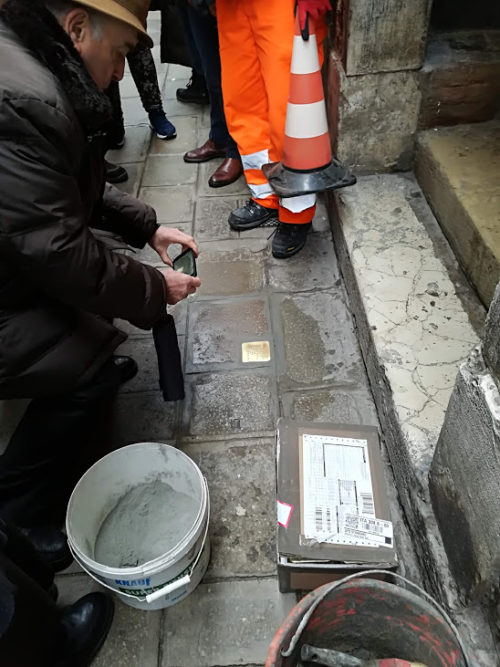
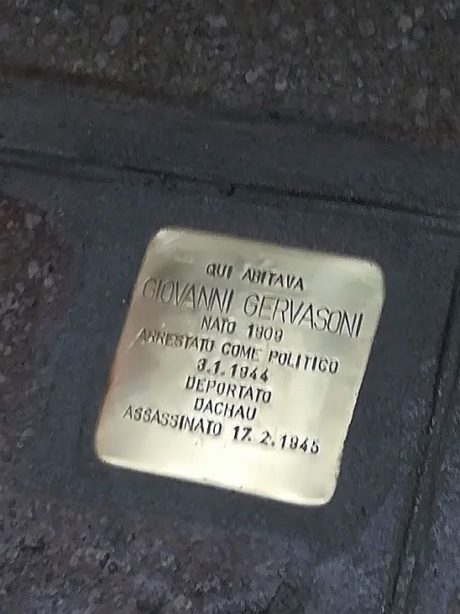
It may seem that I have decided to dedicate my blog to war memorials (and it does begin to seem that way), but I promise I will be broadening the scope and lightening the atmosphere very soon. But not quite yet, because the other morning I joined a large group of people who came to witness the installation of a so-called “stumbling stone” (Stolperstein, in German; pietra d’inciampo in Italian). At the risk of appearing frivolous, let me mention that plenty of Venice’s masegni, or paving stones, are fully capable of tripping people up all by themselves. It happens every day. But these are different.

These “stones” are concrete cubes 10 cm (3.9 inches) on each side which bear a brass plate inscribed with the names of persons who were deported to the Nazi death camps; they are placed in the pavement in front of the house from which that person was taken (usually their home).
The majority of the victims were Jews, but you also risked deportation if you belonged to any of the following categories of non-ideal humans: Romani people, homosexuals, the mentally and physically disabled, Jehovah’s Witnesses, Mormons, blacks, members of the Communist or Social Democratic parties or the anti-Nazi Resistance, the Christian opposition (Catholic and Protestant), Freemasons, military deserters, International Brigades soldiers from the Spanish Civil War, escape helpers, conscientious objectors, capitulators, “habitual criminals,” looters, persons charged with treason, military disobedience or undermining the Nazi military, as well as Allied soldiers.
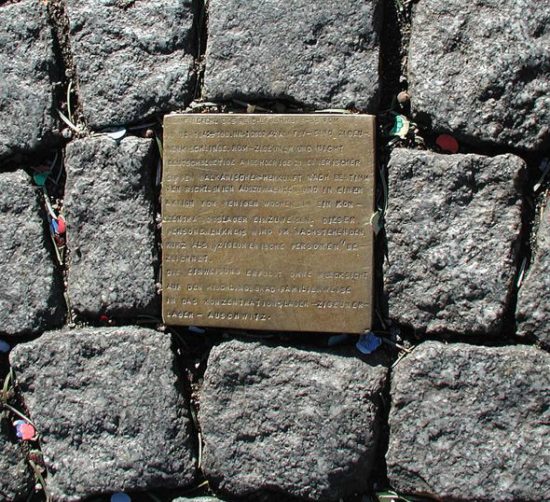
German artist Gunter Demnig began this project in 1992 — he hand-makes each “stone” — and as of October 23, 2018 there were 70,000 in more than 1,200 towns and cities across Europe. The first 12 in Venice were put in place in 2014; the city now counts 78 (including the Lido and San Servolo). For anyone wishing to see any (or all) of the stones in Venice, here is a map.
But why set the memorial into the street? One would expect to see it discreetly placed on a wall, perhaps, but the setting deliberately recalls an anti-Semitic saying in Nazi Germany when someone tripped on a paving stone: “A Jew must be buried there.” Furthermore, as Nazis destroyed Jewish cemeteries they would break up the tombstones, using the pieces in the sidewalks where countless passing feet would desecrate them.


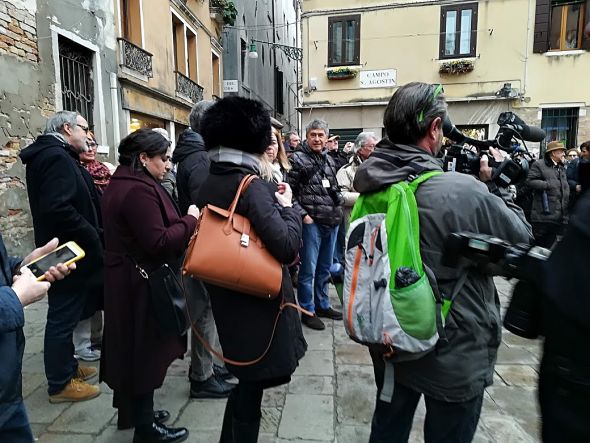
Giovanni Gervasoni was born into a modest Venetian family and studied to become an elementary school teacher. In 1930 he converted to Protestantism, joining the Waldensian Methodist community and working tirelessly in a group which distributed anti-Fascist publications.
Arrested as “a subversive” for the first time in 1932, he began a life of fleeing, hiding, and being under constant surveillance. “His political activity caused him to travel frequently between Venice and Padova,” recalled Alberto Bragaglia, a journalist and Waldensian, quoted in an article on nev.it. Bragaglia’s father, who was then an adolescent, told him that he remembered “a tall, lanky man who would suddenly appear at home and stayed as a guest for several periods of time.”
In 1935 he founded, with some men from the congregation, another group dedicated to the clandestine distribution of material from Giustizia e Liberta‘, an anti-Fascist Resistance group. Just a few months later, in April, he was arrested again and sent to the island of Ventotene, one of the regime’s best-known penal colonies for political prisoners. There he began, with fellow-prisoner Dr. Romola Quarzola, to try to secretly send anti-Fascist tracts to the mainland. Discovered, he was sent to prison in Rome and then Civitavecchia.
In December, 1938 he was sent to the island of Ponza, a prison island near Ventotene; after an extension of his sentence, he was finally liberated in July, 1943, the conclusion of eight years of incarceration. Undaunted, he returned to Venice and began to work as a partisan in collaboration with the Anglo-American forces. Arrested again on January 3, 1944, he was sent to Dachau and killed on February 17, 1945.
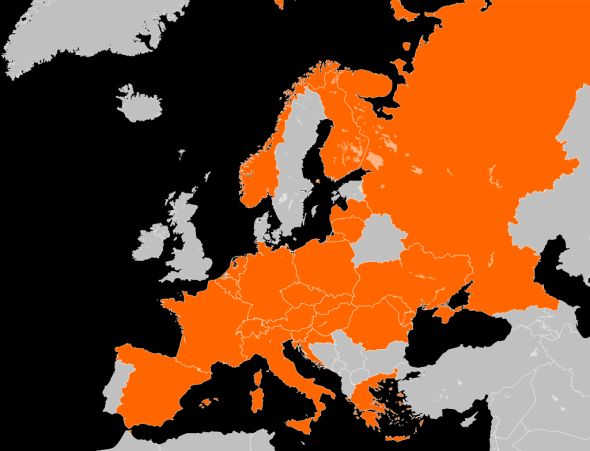
I hope this summary hasn’t bored you; I’ve given it to demonstrate the central point of all the thousands of “stones” across Europe. Gervasoni was only 36 when he died, having spent 15 years, roughly half his life, working against the Nazi-Fascist regime. What this small brass plaque represents, brightly and bravely, isn’t his death, but his life.
I neglected to include photos of another “ripple effect” of tourism: Most of the fruit and vegetable vendors at the Rialto Market are making ends meet by selling packages of dried pasta-sauce mix. These have somewhat replaced the formerly ubiquitous packages of colored pasta (aquamarine fusilli, etc.), but in any case are aimed at the same public.
No need to say more.
